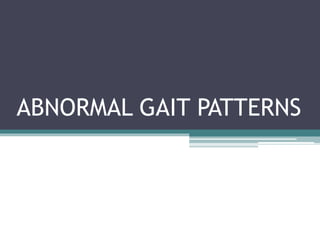
Gait abnormalities presentation
- 2. GAIT & GAIT CYCLE • Human gait refers to locomotion achieved through the movement of human limbs. • Gait is a series of rhythmical & alternating movements of trunk & limbs which result in forward progression of center of gravity & the body. • Gait is a sequence of foot movements by which a person moves forward. • The gait cycle is a repetitive pattern involving steps and strides.
- 3. GAIT CYCLE Classification of the gait cycle involves two main phases: 1. Stance phase 2. Swing phase The stance phase occupies 60% of the gait cycle while the swing phase occupies only 40% of it. Gait involves a combination of open and close chain activities. A more detailed classification of gait recognizes six phases: 1. Heel Strike 2. Foot Flat 3. Mid-Stance 4. Heel-Off 5. Toe-Off 6. Mid-Swing
- 4. GAIT CYCLE An alternative classification of gait involves the following eight phases: 1. Initial Contact 2. Loading Response 3. Midstance 4. Terminal Stance 5. Pre swing 6. Initial Swing 7. Mid Swing 8. Late Swing
- 6. Abnormal Gait Syndromes In general gait deviations fall under four headings: ▫ Pain ▫ Joint muscle range of motion(ROM) limitation ▫ Muscular weakness/paralysis ▫ Neurological involvement(UMN,LMN) ▫ Leg length discrepancies
- 7. Abnormal Gait Hemiplegic gait Scissors gait/ Diplegic gait Myopathic gait Steppage gait Parkinson gait &Propulsive gait Sensory gait
- 8. Hemiplegic Gait • Unilateral weakness on the affected side • Hip into extension, adduction and medial Rotation • Knee in extension • Ankle in drop foot with planterflexion and Inversion (equinovarus), which is present during Stance and swing phases. • In order to clear the foot from ground the knee and hip Should flex • Foot clearance • Hip flexor weakness • Pelvis retracted
- 9. Hemiplegic Gait • Weakness in distal muscles(foot drop) and extensor hypertonia in lower limb. • Most commonly seen in stroke. with mild hemepresis, loss of normal arm swing. • Slight circumduction may be the only abnormalities
- 11. Legs cross midline Adductors Spasticity Toe walk Planter flexor spastic Spastic Cerebral palsy Scissor Gait/ Diplegic Gait Patients have involvement on both sides with spasticity in lower extremities worse than upper extremities. The patient walks with an abnormally narrow base, dragging both legs and scraping the toes. •This gait is seen in bilateral periventricular lesions, such as those seen in cerebral palsy. •Extreme tightness of hip adductors which can cause legs to cross the midline referred to as a scissors gait.
- 12. Myopathic Gait •Hip girdle muscles are responsible for keeping the pelvis level when walking. •If you have weakness on one side, this will lead to a drop in the pelvis on the contralateral side of the pelvis while walking (Trendelenburg sign). •With bilateral weakness, you will have dropping of the pelvis on both sides during walking leading to waddling. •This gait is seen in patient with myopathies, such as muscular dystrophy
- 13. Waddling Gait/ Myopathic Gait Abductor weakness Trenlenberg sign positive Pelvis drop opposite Trunk sway same Lurching Gait Wadding gait
- 14. An unsteady Uncoordinated Wide base Feet thrown out ATAXIC GAIT Most commonly seen in cerebellar disease, this gait is described as • clumsy •staggering movements with a wide-based gait. Patients will not be able to walk from heel to toe or in a straight line. The gait of acute alcohol intoxication will resemble the gait of cerebellar disease.
- 15. Steppage Gait Seen in patients with foot drop (weakness of foot dorsiflexion), the cause of this gait is due to an attempt to lift the leg high enough during walking so that the foot does not drag on the floor. • If unilateral, causes include peroneal nerve palsy and L5 radiculopathy. •If bilateral, causes include amyotrophic lateral sclerosis, Charcot-Marie-Tooth disease
- 16. Steppage/ Foot Drop Foot drop Leg is lifted high so Toes can clear the ground Foot slap at initial contact
- 17. FESTINATING/ PARKINSONIAN GAIT •In this gait, the patient will have rigidity and bradykinesia. •He or she will be stooped with the head and neck forward, with flexion at the knees. •The whole upper extremity is also in flexion with the fingers usually extended. •The patient walks with slow little steps petits pas. •Patient may also have difficulty initiating steps. •The patient may show an involuntary inclination to take accelerating steps, known as festination. This gait is seen in Parkinson's disease or any other condition causing parkinsonism, such as side effects from drugs.
- 18. Involuntarily moves Short steps Accelerating steps Difficult to start Difficult to stop FESTINATING/ PARKINSONIAN GAIT
- 19. Parkinson Gait • Shuffling: small stepped gait without arm swing with high speed. • Festinating: short quick stepped gait with stooped posture due to displaced centre of gravity. • Freezing: sudden brief inability to move during mid stance. • Flat foot strike instead of heel strike
- 20. Propulsive Gait • Stiff neck and head • Excessive force to propel body • Upper trunk stiffness
- 21. Proprioceptive Loss: Sensory Ataxia As our feet touch the ground, we receive propioreceptive information to tell us their location. The sensory ataxic gait occurs when there is loss of this propioreceptive input. This gait is also sometimes referred to as a stomping gait since patients may lift their legs very high to hit the • Wide, irregular, uneven steps • Unsteady, wide based gait • Throw feet forward and out and bring them down first on heels and then toes (double tapping sound) • Watch ground • Positive Romberg (cannot stand with feet together and eyes closed) • Friedrich ataxia
